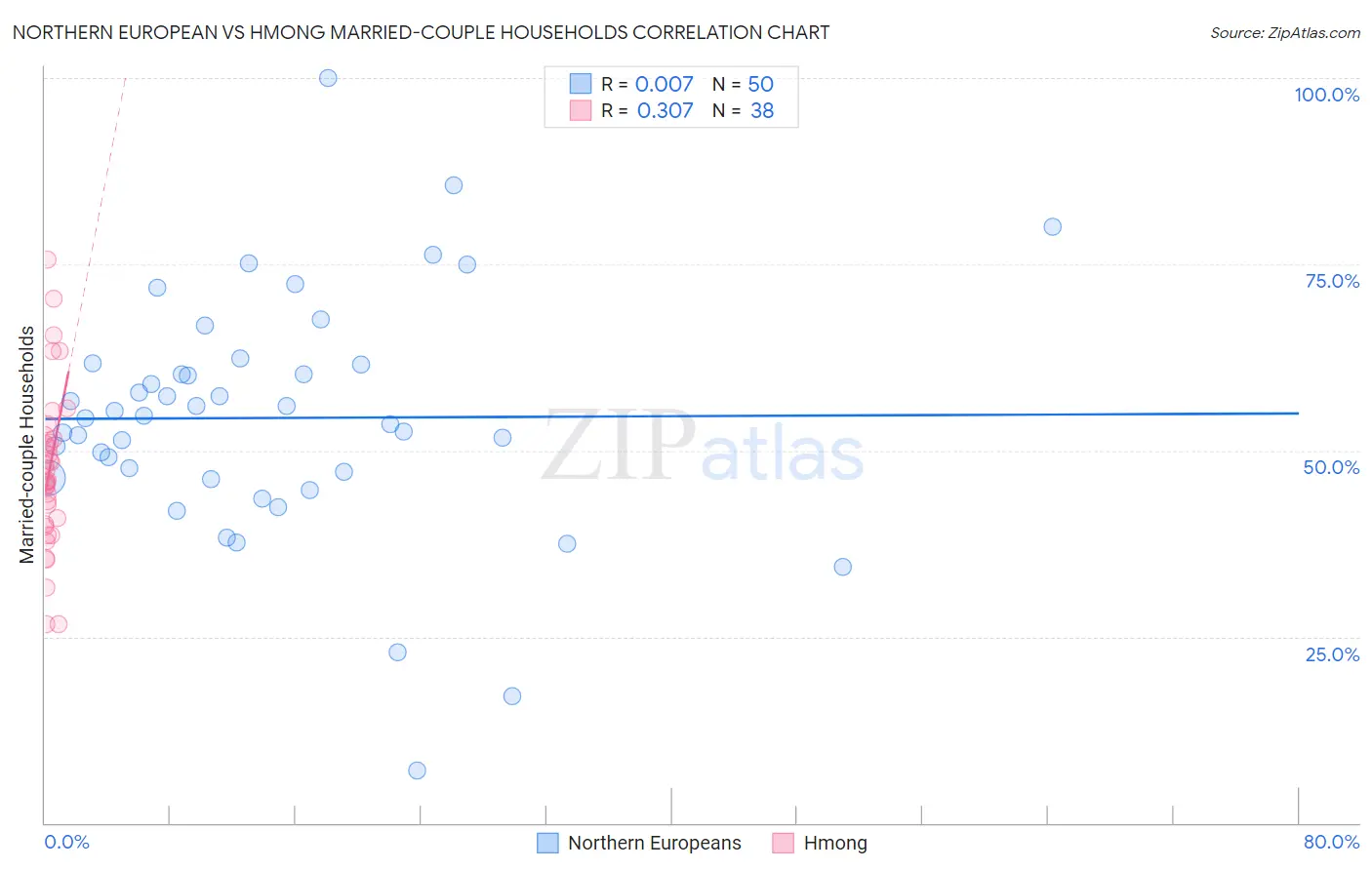Northern European vs Hmong Married-couple Households
COMPARE
Northern European
Hmong
Married-couple Households
Married-couple Households Comparison
Northern Europeans
Hmong
48.4%
MARRIED-COUPLE HOUSEHOLDS
99.0/ 100
METRIC RATING
64th/ 347
METRIC RANK
47.0%
MARRIED-COUPLE HOUSEHOLDS
76.2/ 100
METRIC RATING
153rd/ 347
METRIC RANK
Northern European vs Hmong Married-couple Households Correlation Chart
The statistical analysis conducted on geographies consisting of 405,935,779 people shows no correlation between the proportion of Northern Europeans and percentage of married-couple family households in the United States with a correlation coefficient (R) of 0.007 and weighted average of 48.4%. Similarly, the statistical analysis conducted on geographies consisting of 24,669,739 people shows a mild positive correlation between the proportion of Hmong and percentage of married-couple family households in the United States with a correlation coefficient (R) of 0.307 and weighted average of 47.0%, a difference of 3.2%.

Married-couple Households Correlation Summary
| Measurement | Northern European | Hmong |
| Minimum | 7.1% | 26.6% |
| Maximum | 100.0% | 75.6% |
| Range | 92.9% | 49.0% |
| Mean | 54.4% | 47.3% |
| Median | 54.5% | 46.0% |
| Interquartile 25% (IQ1) | 46.4% | 40.1% |
| Interquartile 75% (IQ3) | 61.6% | 51.6% |
| Interquartile Range (IQR) | 15.2% | 11.5% |
| Standard Deviation (Sample) | 16.3% | 10.7% |
| Standard Deviation (Population) | 16.1% | 10.6% |
Similar Demographics by Married-couple Households
Demographics Similar to Northern Europeans by Married-couple Households
In terms of married-couple households, the demographic groups most similar to Northern Europeans are Basque (48.4%, a difference of 0.010%), Immigrants from Canada (48.4%, a difference of 0.020%), Jordanian (48.4%, a difference of 0.040%), Romanian (48.4%, a difference of 0.050%), and Immigrants from South Eastern Asia (48.4%, a difference of 0.060%).
| Demographics | Rating | Rank | Married-couple Households |
| Poles | 99.2 /100 | #57 | Exceptional 48.5% |
| Immigrants | Indonesia | 99.2 /100 | #58 | Exceptional 48.5% |
| Czechoslovakians | 99.2 /100 | #59 | Exceptional 48.5% |
| Croatians | 99.1 /100 | #60 | Exceptional 48.5% |
| Bulgarians | 99.1 /100 | #61 | Exceptional 48.5% |
| Luxembourgers | 99.1 /100 | #62 | Exceptional 48.5% |
| Basques | 99.0 /100 | #63 | Exceptional 48.4% |
| Northern Europeans | 99.0 /100 | #64 | Exceptional 48.4% |
| Immigrants | Canada | 99.0 /100 | #65 | Exceptional 48.4% |
| Jordanians | 98.9 /100 | #66 | Exceptional 48.4% |
| Romanians | 98.9 /100 | #67 | Exceptional 48.4% |
| Immigrants | South Eastern Asia | 98.9 /100 | #68 | Exceptional 48.4% |
| Immigrants | China | 98.9 /100 | #69 | Exceptional 48.4% |
| Immigrants | North America | 98.9 /100 | #70 | Exceptional 48.4% |
| Laotians | 98.8 /100 | #71 | Exceptional 48.4% |
Demographics Similar to Hmong by Married-couple Households
In terms of married-couple households, the demographic groups most similar to Hmong are Immigrants from Western Asia (46.9%, a difference of 0.0%), Serbian (47.0%, a difference of 0.010%), Arab (46.9%, a difference of 0.010%), Immigrants from Bulgaria (47.0%, a difference of 0.030%), and Armenian (46.9%, a difference of 0.040%).
| Demographics | Rating | Rank | Married-couple Households |
| Immigrants | Western Europe | 81.6 /100 | #146 | Excellent 47.1% |
| Immigrants | Syria | 81.6 /100 | #147 | Excellent 47.1% |
| Icelanders | 79.5 /100 | #148 | Good 47.0% |
| Paraguayans | 78.7 /100 | #149 | Good 47.0% |
| Immigrants | Russia | 77.6 /100 | #150 | Good 47.0% |
| Immigrants | Bulgaria | 76.8 /100 | #151 | Good 47.0% |
| Serbians | 76.3 /100 | #152 | Good 47.0% |
| Hmong | 76.2 /100 | #153 | Good 47.0% |
| Immigrants | Western Asia | 76.1 /100 | #154 | Good 46.9% |
| Arabs | 76.0 /100 | #155 | Good 46.9% |
| Armenians | 75.4 /100 | #156 | Good 46.9% |
| Immigrants | Oceania | 74.8 /100 | #157 | Good 46.9% |
| Immigrants | Nonimmigrants | 73.3 /100 | #158 | Good 46.9% |
| Osage | 73.2 /100 | #159 | Good 46.9% |
| Iraqis | 71.7 /100 | #160 | Good 46.9% |